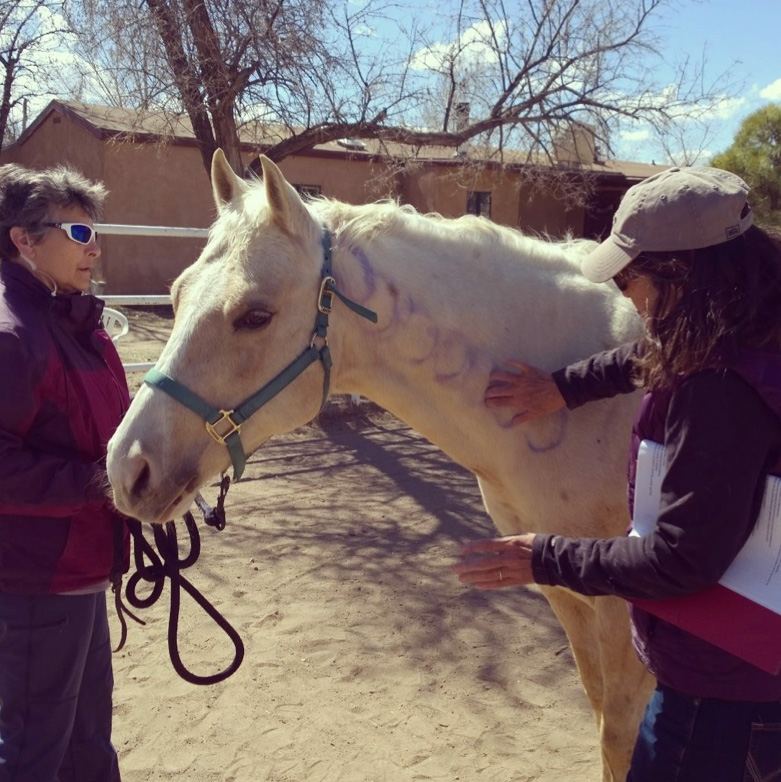Equine Body Balance “Bodywork for Equines”

The online class format for Equine Body Balance “Bodywork for Equines” class is adapted from the actual hands-on class in order to provide a rewarding student experience without the student needing to leave their own homes or barns. The student may also take the course at their leisure, without having to adhere to a specific time and place requirement.
Included in the course are videos, article links, detailed instructions on techniques shown in the videos, and lesson quizzes. It is a good idea for students to have an equine anatomy book to refer to.
What you will need for this class:
- Good equine anatomy book
- Safe horse to work with
- Ability to view videos preferably in the field as well as at home, i.e. – phone, laptop, iPad
Like the hands-on class, Bodywork for Equines is for the owner who is interested in learning some tools to maintain their own horses’ health and horse professionals who are interested in sustainable ways to assist in the healing of horses. The class aims to foster a holistic view of the horse and people’s relationship to it through non-force intention. Equine Body Balance balances the horse’s systems and allows for better functionality. It allows people to be more proactive in their horse’s health care by learning how to observe a horse’s condition, and hands-on techniques to address injury, restriction and improve overall movement, health and soundness. Knowledge of what the horse is capable of doing influences how we train and what we can expect from the horse.
As with EBB onsite classes, this material is not a substitute for veterinary care but rather a complement to it.
There are many bodywork approaches for both horses and humans. Equine Body Balance(TM), informed by Ortho-Bionomy(R), is unique in it that relies on the body’s self-correcting response, and functions within the principle of “less is more.” This may seem contrary to chiropractic, massage and other modalities whose tenets rely on stronger physical techniques, but it is equally, if not more, powerful in many cases. The work addresses all body systems, spanning soft tissue, bone structure, soft skeleton, organs, circulation, lymph and much more.
The online course is divided into six lessons, with a small quiz at the end of each one to help assess your understanding of materials. The quizzes will be multiple choice, true/false, and essay. Those who want to receive a completion certificate for this online class must complete the quizzes. The course is 16 hours, which comprises the six lessons, personal review and practice, quizzes, and included in that time 5 hours of self-study that will include consult with the instructor. The course will be active for 90 days. Instructor is available for questions via email during this time for a period of 1 hour. Additional time will be charged separately as consultation.
Hands-on classes focusing on this material are available in various locations in the U.S.
Class Content
- Approaching the horse – greeting, coming into connection.
- Assessment: observe the horse, the gait, movement patterns and gestures.
- Techniques such as lifting legs in position of comfort, caving around an area of pain, addressing trigger points.
- Learning to feel tissue differences, i.e., sinewy, squishy, tissue with bounce-back, hard
- Response: Learn to notice the horse’s ability to respond to the treatment, including reflexive action. Learn to work at the level of each horse, and tailor the session to the needs of the individual horse.
- Being aware of your own comfort while working on the horse.
Instructor
Susan Smith is Instructor of Equine Body Balance(TM), and Registered Instructor & Advanced Practitioner of Ortho-Bionomy(R) and Equine Ortho-Bionomy(R); and Equine Positional Release(R) practitioner. She has been involved in equine activities and bodywork for over 20 years. Her articles have appeared in Trail Blazer Magazine, Western Horseman, Equine Wellness, Horse Around New Mexico and many others.
Glossary of Terms
- Cranial – Toward the head
- Caudal – Toward the tail
- Rostral – Toward the tip of the nose
- Medial – towards the midline
- Lateral – away from the midline
- Anterior – toward or at the front of the body
- Posterior – toward the backside of the body
- Dorsal – toward the back
- Ventral – toward the abdomen
Articular processes of a vertebra are projections of the vertebra that serve the purpose of fitting with an adjacent vertebra. The actual region of contact is called the articular facet. – Wikipedia
Spinous process is a bony projection off the posterior (back) of each vertebra. The spinous process protrudes laminae of the vertebral arch join and provides the point of attachment for muscles and ligaments of the spine. – SpineHealth.com (think of the horse’s spine at the horse’s topline eds. note)
The two transverse processes, one on each side of the vertebral body project from either side at the point where the lamina joins the pedicle (stalklike structure) between the superior and inferior articular processes…. A facet on each of the transverse processes of the thoracic vertebral bodies articulates with the head of the rib. – Wikipedia
Lessons
Bodywork for Equines – Lesson 1
What Equine Body Balance is About
Bodywork for Equines – Lesson 2
Physical Orientation and Assessment
Bodywork for Equines – Lesson 3
Sternum and Shoulders
Bodywork for Equines – Lesson 4
Thoracic Vertebrae
Bodywork for Equines – Lesson 5
Lumbars, Sacrum and Pelvis
Bodywork for Equines – Lesson 6
The Neck – Cervical Spine


